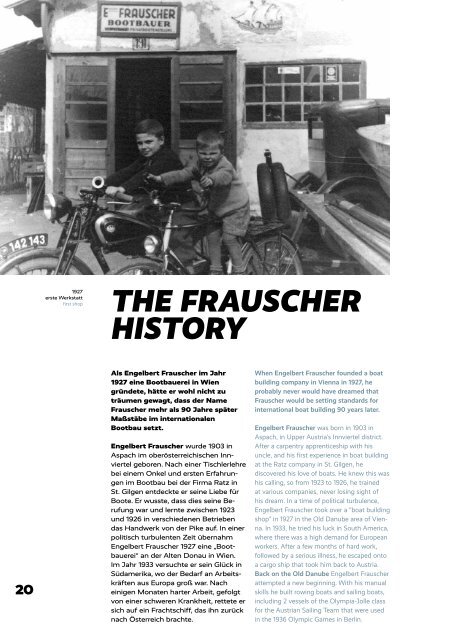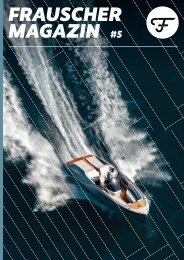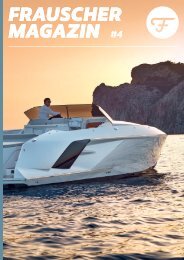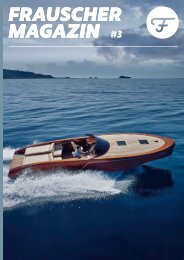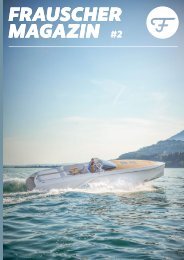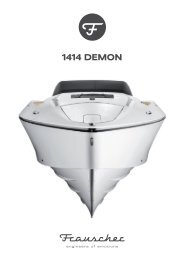Frauscher Magazin #1
The Frauscher shipyard gives insights into the design, the boat building and their model range in their first magazine! About the Frauscher shipyard: Frauscher Shipyard, with headquarters in Ohlsdorf, Austria, is unique in offering high-quality and innovative motor and electric boats that are valued by experts and boat enthusiasts from around the world: especially due to the striking design and superior craftsmanship – “Made in Austria”.
The Frauscher shipyard gives insights into the design, the boat building and their model range in their first magazine!
About the Frauscher shipyard:
Frauscher Shipyard, with headquarters in Ohlsdorf, Austria, is unique in offering high-quality and innovative motor and electric boats that are valued by experts and boat enthusiasts from around the world: especially due to the striking design and superior craftsmanship – “Made in Austria”.
Create successful ePaper yourself
Turn your PDF publications into a flip-book with our unique Google optimized e-Paper software.
1927<br />
erste Werkstatt<br />
first shop<br />
THE FRAUSCHER<br />
HISTORY<br />
Als Engelbert <strong>Frauscher</strong> im Jahr<br />
1927 eine Bootbauerei in Wien<br />
gründete, hätte er wohl nicht zu<br />
träumen gewagt, dass der Name<br />
<strong>Frauscher</strong> mehr als 90 Jahre später<br />
Maßstäbe im internationalen<br />
Bootbau setzt.<br />
Engelbert <strong>Frauscher</strong> wurde 1903 in<br />
Aspach im oberösterreichischen Innviertel<br />
geboren. Nach einer Tischlerlehre<br />
bei einem Onkel und ersten Erfahrungen<br />
im Bootbau bei der Firma Ratz in<br />
St. Gilgen entdeckte er seine Liebe für<br />
Boote. Er wusste, dass dies seine Berufung<br />
war und lernte zwischen 1923<br />
und 1926 in verschiedenen Betrieben<br />
das Handwerk von der Pike auf. In einer<br />
politisch turbulenten Zeit übernahm<br />
Engelbert <strong>Frauscher</strong> 1927 eine „Bootbauerei“<br />
an der Alten Donau in Wien.<br />
Im Jahr 1933 versuchte er sein Glück in<br />
Südamerika, wo der Bedarf an Arbeitskräften<br />
aus Europa groß war. Nach<br />
20 einigen Monaten harter Arbeit, gefolgt skills he built rowing boats and sailing boats,<br />
21<br />
von einer schweren Krankheit, rettete er<br />
sich auf ein Frachtschiff, das ihn zurück<br />
nach Österreich brachte.<br />
When Engelbert <strong>Frauscher</strong> founded a boat<br />
building company in Vienna in 1927, he<br />
probably never would have dreamed that<br />
<strong>Frauscher</strong> would be setting standards for<br />
international boat building 90 years later.<br />
Engelbert <strong>Frauscher</strong> was born in 1903 in<br />
Aspach, in Upper Austria’s Innviertel district.<br />
After a carpentry apprenticeship with his<br />
uncle, and his first experience in boat building<br />
at the Ratz company in St. Gilgen, he<br />
discovered his love of boats. He knew this was<br />
his calling, so from 1923 to 1926, he trained<br />
at various companies, never losing sight of<br />
his dream. In a time of political turbulence,<br />
Engelbert <strong>Frauscher</strong> took over a “boat building<br />
shop” in 1927 in the Old Danube area of Vienna.<br />
In 1933, he tried his luck in South America,<br />
where there was a high demand for European<br />
workers. After a few months of hard work,<br />
followed by a serious illness, he escaped onto<br />
a cargo ship that took him back to Austria.<br />
Back on the Old Danube Engelbert <strong>Frauscher</strong><br />
attempted a new beginning. With his manual<br />
including 2 vessels of the Olympia-Jolle class<br />
for the Austrian Sailing Team that were used<br />
in the 1936 Olympic Games in Berlin.<br />
1927 - 2020<br />
1955<br />
Bootsverleih<br />
boat rental<br />
Zurück an der Alten Donau versuchte<br />
Engelbert <strong>Frauscher</strong> einen Neustart.<br />
Mit seinem handwerklichen Können<br />
baute er Ruder- und Segelboote,<br />
darunter 2 Olympia-Jollen für den<br />
Österreichischen Segelverein, die bei<br />
den Olympischen Spielen in Berlin<br />
1936 zum Einsatz kamen.<br />
Doch die Wirren des zweiten Weltkrieges<br />
warfen auch ihre Schatten über<br />
das Leben der Familie <strong>Frauscher</strong>. Im<br />
Jahr 1944 wurde die Werkstatt an<br />
der Alten Donau in Wien samt der<br />
daneben liegenden Wohnung bei einem<br />
Bombenangriff schwer beschädigt.<br />
Sein erst 17-jähriger Sohn Kurt wurde<br />
zum Militär eingezogen und galt nach<br />
Kriegsende als vermisst. Fanny <strong>Frauscher</strong>,<br />
die Gattin von Engelbert, war mit den<br />
beiden jüngeren Söhnen Ernst und<br />
Hans nach Geinberg in Oberösterreich<br />
zu Verwandten gezogen. Engelbert<br />
<strong>Frauscher</strong> überließ nach dem Krieg<br />
seinem langjährigen Lehrling das<br />
Gelände der Bootswerft an der Alten<br />
Donau und ging ebenfalls zu seiner<br />
Familie nach Geinberg.<br />
In der Nachkriegszeit befand sich in<br />
Gmunden das amerikanische Oberkommando<br />
und die amerikanischen<br />
Besatzer übernahmen den Yachtklub.<br />
Man suchte einen Bootbauer, der die<br />
Wartung der Boote übernehmen konnte<br />
und fand in Engelbert <strong>Frauscher</strong> den<br />
passenden Mann. Sein Arbeits- und<br />
Schlafplatz war die Werft im Stadtteil<br />
Weyer in Gmunden. Dort, wo heute der<br />
<strong>Frauscher</strong> Bootshafen ist, arbeitete<br />
Engelbert <strong>Frauscher</strong> in einer alten Werkstätte<br />
der Firma Wicke, die in Konkurs<br />
gegangen war. Nach dem Abzug der<br />
Amerikaner aus Gmunden wurden die<br />
Boote wieder an ihre Besitzer zurückgegeben<br />
und die Werft aufgelassen.<br />
Herr Schmid, Yachtclub-Mitglied, wurde<br />
der neue Eigentümer und verkaufte<br />
die Werft sehr günstig an Engelbert<br />
<strong>Frauscher</strong>. Er wollte einen Boot bauer in<br />
der Nähe des Yachtclubs haben. In dieser<br />
Zeit gab es nur Holzboote und ein<br />
Fachmann wie <strong>Frauscher</strong> war schwer<br />
zu finden. Er übernahm Reparaturen,<br />
baute kleine Ruderboote und begann<br />
auch wieder mit den O-Jollen. Seine<br />
Frau Fanny war die Finanzverwalterin.<br />
But the turmoil of World War II also cast a<br />
shadow on the life of the <strong>Frauscher</strong> family.<br />
In 1944 the Old Danube shop in Vienna was<br />
heavily damaged in an air raid, together with<br />
the flat next door. His son Kurt, who was only<br />
17 years old, was conscripted into military<br />
service and was listed as missing after the<br />
war. Fanny <strong>Frauscher</strong>, Engelbert’s wife, had<br />
moved with the two other sons, Ernst and<br />
Hans, to live with relatives in Geinberg in<br />
Upper Austria. After the war, Engelbert<br />
<strong>Frauscher</strong> left the shipyards grounds on the<br />
Old Danube to his long-time apprentice,<br />
and joined his family in Geinberg.<br />
In the post-war years Gmunden was the<br />
location of the American command<br />
headquarters, and the American occupying<br />
forces took over the yacht club. A position<br />
opened for a boat builder who could service<br />
the boats, and Engelbert <strong>Frauscher</strong> was the<br />
man for the job. His workplace and accommodations<br />
were at the shipyard in the Weyer<br />
district of Gmunden, where the company now<br />
has its harbour. Engelbert <strong>Frauscher</strong> worked in<br />
an old shop of the Wicke company, which had<br />
gone bankrupt. After the withdrawal of the<br />
American troops from Gmunden, the boats<br />
were returned to their owners and the<br />
shipyard was shut down. Mr. Schmid, a<br />
member of the yacht club, became the new<br />
owner, and sold the shipyard to Engelbert<br />
<strong>Frauscher</strong> for a very reasonable price. He<br />
wanted to have a boat builder near the yacht<br />
club. During that time, there were only<br />
wooden boats, and an expert like <strong>Frauscher</strong><br />
was hard to find. He did the repairs, built<br />
small rowing boats, and started building the<br />
O-Jolle boats again. His wife Fanny managed<br />
the finances.


